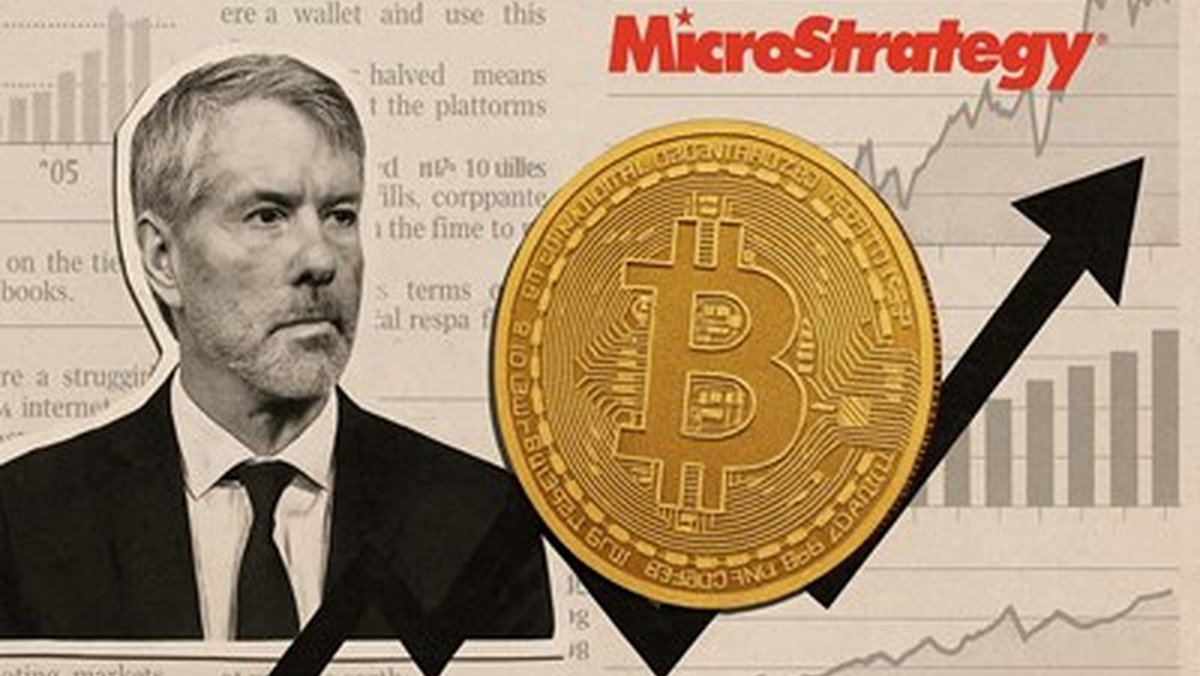Did Wall Street "Break" Bitcoin? Why Michael Saylor Thinks the Market Is Actually Maturing
Every time Bitcoin stumbles, someone looks for a new villain. In the latest selloff – with BTC sliding about 12% in a week to the 91,000 USD area (according to the context you provided) and MicroStrategy’s heavily leveraged Bitcoin strategy taking a hit – many fingers pointed straight at Wall Street.
The argument from skeptics is simple: once ETFs, big banks and macro hedge funds showed up, they turned Bitcoin into just another instrument in the risk-on, risk-off machine. Instead of a neutral, uncorrelated monetary asset, BTC is now at the mercy of ETF flows, basis trades and algorithmic funds that dump it at the first sign of trouble in rates or equities.
Michael Saylor, Executive Chairman of MicroStrategy and one of Bitcoin’s loudest corporate evangelists, is having none of it. In his latest remarks, he pushes back on the idea that Wall Street’s involvement has “damaged” Bitcoin. On the contrary, he insists that:
- Bitcoin’s volatility has already fallen significantly – from around 80% annualised in 2020 to nearer 50% today, in his framing.
- As the market matures and more institutional capital enters, he expects that volatility to trend even lower.
- MicroStrategy itself is designed to survive 80–90% drawdowns in Bitcoin without impairing its operational business.
Not everyone is convinced. A veteran trader operating under the pseudonym Peter Pan has warned that if Bitcoin ever experiences a deep, prolonged downturn resembling the deflation of the speculative bubbles of the 1970s – when some glamour stocks lost 80–90% of their value and never truly recovered – MicroStrategy’s ultra-concentrated balance sheet could face serious stress.
So who is seeing the landscape more clearly: Saylor, who views volatility as a shrinking tax on long-term adopters, or the skeptics who fear that Wall Street has introduced a new layer of systemic risk into Bitcoin’s DNA?
This article unpacks the debate through three lenses:
- How Bitcoin’s volatility has actually changed over time.
- What Wall Street really does to an asset once it “moves in”.
- How MicroStrategy’s strategy looks under extreme but plausible stress scenarios.
Note: some specific figures mentioned – such as the 91,616 USD spot level and the latest weekly drawdown – come from your prompt and cannot be independently verified here. The analytical frameworks, however, are general and do not depend on a particular day’s price.
1. Has Bitcoin’s volatility really collapsed?
Start with Saylor’s central claim: Bitcoin’s volatility is falling over time, and Wall Street is not making it worse.
There are multiple ways to measure volatility: realised daily volatility, 30-day annualised volatility, the size of peak-to-trough drawdowns, or even the distribution of intraday ranges. No matter which metric you choose, early Bitcoin was extraordinarily wild compared with today. Drug-fuelled exchange hacks, tiny order books and thin liquidity meant that 20–30% daily swings were not rare; they were the norm.
As the asset has grown, several things have changed:
- Market depth has improved. Spot markets on large exchanges now handle billions of dollars in volume daily. It still only takes one large player to move the market, but it no longer takes one moderately sized whale to collapse it.
- Derivatives have proliferated. Futures, options and structured products allow traders to hedge and arbitrage price swings, damping some of the most extreme moves even as they introduce new leverage cycles.
- Macro participants have arrived. For all their flaws, ETF issuers, arb funds and institutional desks bring more two-way flow than the retail-only market of a decade ago.
That doesn’t mean Bitcoin is “low volatility” in any absolute sense – a 50% annualised volatility is still astronomical compared with most commodities or currencies. But Saylor’s broader point is defensible: the relative amplitude of the cycles has been drifting downward over each full halving cycle, and extreme events now tend to be framed more by macro shocks (Fed policy, liquidity conditions) than by exchange blow-ups.
Where critics push back is in the time frame. Volatility can fall structurally while still delivering brutal, portfolio-wrecking episodes along the way. A drop from 80% to 50% volatility is small comfort to the margin-long trader who watched Bitcoin fall 12% in a week and 30–40% over a few months. From that vantage point, Wall Street’s presence can feel like more of the same pain, just wearing a sharp suit.
2. What Wall Street actually does to an asset
The contention that “Wall Street has harmed Bitcoin” rests on a specific story: institutions arrived, financialised the asset, and in doing so introduced new fragilities. It is worth unpacking the mechanisms behind that story.
2.1 The upside: deeper liquidity, tighter spreads
When large intermediaries enter a market, they usually bring:
- More consistent liquidity. Market-makers quoting both sides of the order book during most conditions.
- Arbitrage between venues. Funds specialising in cross-market trades narrow price gaps between exchanges or between spot and derivatives, which stabilises pricing.
- Access for new capital. Spot ETFs, ETPs and brokerage integrations let pension funds, corporate treasuries and conservative wealth managers allocate without touching on-chain infrastructure.
All of these forces tend to reduce idiosyncratic volatility. A single exchange outage, for example, is less systemically destabilising when a large proportion of volume has migrated into ETF wrappers or when sophisticated arbitrageurs step in to exploit mispricings instead of panic.
2.2 The downside: correlation and flow-driven selloffs
But Wall Street does not come for free. It also changes an asset in ways that Saylor’s bullish framing glosses over:
- Higher macro correlation. Once Bitcoin is held in multi-asset portfolios, it tends to be treated like other risk assets. When rates rise or credit stresses emerge, risk is cut across the board – and BTC gets sold alongside high-growth stocks and high-yield bonds.
- Flow reflexivity. ETFs create a new feedback loop. Net redemptions require the ETF to sell physical BTC; sustained selling becomes self-reinforcing, especially if it coincides with deteriorating sentiment in spot markets.
- Leverage through structured trades. Dealers and hedge funds don’t just buy Bitcoin; they build basis trades, volatility trades and relative value positions that can unwind violently when assumptions break, dumping inventory into the market all at once.
The recent drawdown illustrates this double-edged sword. On the way up, ETF inflows and institutional adoption helped propel Bitcoin to six-figure levels. On the way down, the same channels acted as high-capacity exit ramps. Bitcoin didn’t become more fragile in a purely technical sense, but it became more tightly wired into the global risk cycle.
From Saylor’s perspective as a multi-cycle hodler, this is acceptable. He sees volatility as a tax paid by impatient speculators. From the perspective of a new entrant who bought the top because an ETF ad made Bitcoin look like digital blue-chip gold, the experience can feel more like a trap.
3. MicroStrategy: visionary balance sheet or leveraged bubble proxy?
To understand why emotions run so high when Saylor dismisses concerns about volatility, we need to look at his own company’s positioning.
MicroStrategy started as a business intelligence and software firm. Over the last several years, it has transformed into the most aggressive corporate accumulator of Bitcoin on the planet. The firm has repeatedly:
- Issued convertible debt, senior notes and equity to raise fiat capital.
- Deployed large portions of that capital into Bitcoin purchases at various price levels.
- Framed the strategy as a long-term bet that BTC will outpace both inflation and traditional equities.
As a result, its balance sheet has become dominated by Bitcoin holdings. In bull markets, this has produced spectacular paper gains; MicroStrategy’s share price has often moved with even higher beta than Bitcoin itself. In drawdowns, the effect works in reverse.
Critically, Saylor insists that MicroStrategy is built to endure. In his telling, the company can shrug off an 80–90% Bitcoin price collapse without compromising core operations. That confidence rests on several pillars:
- Long-dated debt. Much of the company’s borrowing is fixed-rate and does not require daily mark-to-market margin calls like a leveraged futures position would.
- Operating business cash flows. The legacy software business, while overshadowed in market cap terms by Bitcoin holdings, still generates revenue that can cover operating expenses.
- Hodler culture. Saylor’s stated intention is to hold Bitcoin indefinitely, not to trade it. That removes one source of forced selling pressure.
Peter Pan and other skeptics counter that this confidence may be overstated. The comparison he draws – to the investment bubbles of the 1970s – is not about exact historical parallels but about path dependency and fragility.
In the “Nifty Fifty” era, for example, a handful of growth stocks were treated as untouchable. Valuations soared under the assumption that these companies could always grow into their multiples. When macro conditions changed and sentiment broke, many of those names fell 70–90% and never returned to prior peaks, even if the underlying businesses survived.
Applied to MicroStrategy, the concern is that:
- The company’s market valuation may embed not just Bitcoin’s current price, but also aggressive assumptions about its future path.
- If Bitcoin were to suffer one more “classic” 80% drawdown – say, from the low six figures back to the 20,000–25,000 range – MicroStrategy’s equity could face a double hit: from the direct impact on the balance sheet and from multiple compression as investors reassess risk.
- In such a scenario, rolling over debt or raising new capital could become more difficult and expensive, especially if broader credit markets were also stressed.
Saylor’s rejoinder is that this is all short-term noise. If you believe that Bitcoin is marching toward eventual multi-hundred-thousand or even million-dollar territory over the coming decades, then the precise path matters less. From that vantage point, volatility is just the price of admission.
The analytical problem is that both narratives can be internally consistent. It is entirely possible for MicroStrategy to survive a brutal multi-year drawdown and thrive on the other side – and it is also possible for equity holders to experience devastating dilution or permanent capital loss along the way.
4. Volatility versus solvency: the key distinction
One way to cut through the rhetoric is to distinguish between price volatility and solvency risk.
Saylor is right that volatility alone does not equal risk for an investor with:
- A very long time horizon.
- No leverage.
- The psychological ability to ignore mark-to-market swings.
If such an investor buys Bitcoin at 91,000, watches it fall to 45,000, and then holds it for ten years until it reaches 300,000, the interim volatility was unpleasant but ultimately irrelevant to their outcome.
Most real-world investors, however, do not live in that frictionless world. They face:
- Margin calls, collateral requirements and regulatory capital rules.
- Investor redemptions, board pressure or personal life events that force sales.
- Cognitive limits that make it hard to hold assets that appear to be collapsing.
For them, volatility can trigger forced behaviour – exactly the kind of thing that drives cascading selloffs. When skeptics say Wall Street has “harmed” Bitcoin, what they often mean is that the composition of holders has changed. There are now many more actors whose hands are not diamond, but glass.
MicroStrategy sits somewhere in between. It has long-dated debt and ideological commitment, but it is still a public company answerable to shareholders and creditors. Volatility may not destroy the business, but it can severely punish late-arriving equity holders who bought the dream rather than the balance sheet math.
5. Is the latest crash proof of anything?
It is tempting to read every sharp drawdown as a verdict on one side of the argument. Bitcoin falls 12% in a week, and critics proclaim that Wall Street wrecked it. The price rallies back above prior highs, and the hodlers declare vindication.
In reality, a single crash is often just data, not destiny. The most recent move lower can be explained by a laundry list of familiar factors: profit-taking after a parabolic run, ETF outflows as macro jitters rise, leveraged long liquidations, and the usual dose of reflexive panic in social media sentiment.
On its own, it doesn’t prove that volatility is permanently falling or that it is forever high. It doesn’t prove that Bitcoin has become “just another tech stock” or that it stands apart as digital gold. It certainly doesn’t prove that MicroStrategy’s strategy is either bulletproof or doomed.
What it does illustrate is the new shape of Bitcoin’s risk:
- Crashes tend to be driven more by macro and flow dynamics than by isolated crypto-native scandals.
- Institutional structures like ETFs both smooth access and amplify herd behaviour.
- Corporate actors like MicroStrategy can become powerful narrative anchors – for better or worse – in how the market interprets each move.
In that environment, Saylor’s calm about volatility and Peter Pan’s warnings about bubble-like risk are less mutually exclusive than they appear. Both are describing different slices of the same elephant.
6. What professional investors should actually do with this debate
For a professional news and analysis audience, the Saylor-versus-skeptics debate is useful not as drama, but as a prompt to ask sharper questions about Bitcoin allocation and risk management.
Some of those questions include:
- What is my true time horizon? If your capital cannot remain deployed for at least one full halving cycle without forced liquidation, you cannot treat volatility purely as an abstract statistic.
- How am I getting exposure? Spot, self-custody, ETF, futures and equity proxies like MicroStrategy all embed different leverage, liquidity and counterparty profiles.
- What role is Bitcoin playing in my portfolio? Hedge against fiat debasement, tech-growth proxy, trading vehicle, or collateral asset? Each role reacts differently to volatility and macro shocks.
- How sensitive is my strategy to ETF flows and macro correlations? If your thesis assumes Bitcoin is uncorrelated, you need to revisit that in light of Wall Street’s growing footprint.
None of these questions have universal answers. They do, however, frame the discussion more productively than simply asking whether Wall Street has “hurt” Bitcoin or whether Saylor is “right”.
Conclusion: Bitcoin is evolving – and so is the risk
Michael Saylor’s dismissal of fears that Wall Street has damaged Bitcoin is grounded in a long-term, high-conviction view: over time, volatility will fall, adoption will expand, and early holders willing to weather savage drawdowns will be rewarded. On that multi-decade horizon, short-term ETF outflows and twelve-percent weekly drops are indeed noise.
Critics like Peter Pan look at the same facts and see a different picture: an asset that is increasingly bound to the hip of global risk cycles, promoted by highly leveraged corporate actors, and owned by many investors who may not be psychologically or structurally equipped to survive another 80–90% bear market. In that framing, glibly waving away volatility is dangerous.
Both perspectives capture part of the truth. Wall Street has not “broken” Bitcoin, but it has changed the way Bitcoin behaves. Volatility may be slowly declining in structural terms, but it remains brutal enough to destroy overleveraged or misaligned participants. MicroStrategy may well endure even a deep bear market, but that does not guarantee a smooth ride for its shareholders.
For serious investors, the task is not to choose a hero in the narrative war. It is to understand the new market structure Bitcoin inhabits, to model how different stress scenarios would affect their chosen exposure, and to decide consciously how much of that volatility tax they are willing – and able – to pay.
Disclaimer: This article is based on user-supplied contextual information about recent price levels and commentary by market participants. Those specific data points could not be independently verified here. The analysis is intended for informational and educational purposes only and does not constitute investment, trading, legal or tax advice. Digital assets are highly volatile and may be unsuitable for many investors. Always conduct your own research and consider consulting a qualified professional before making financial decisions.







